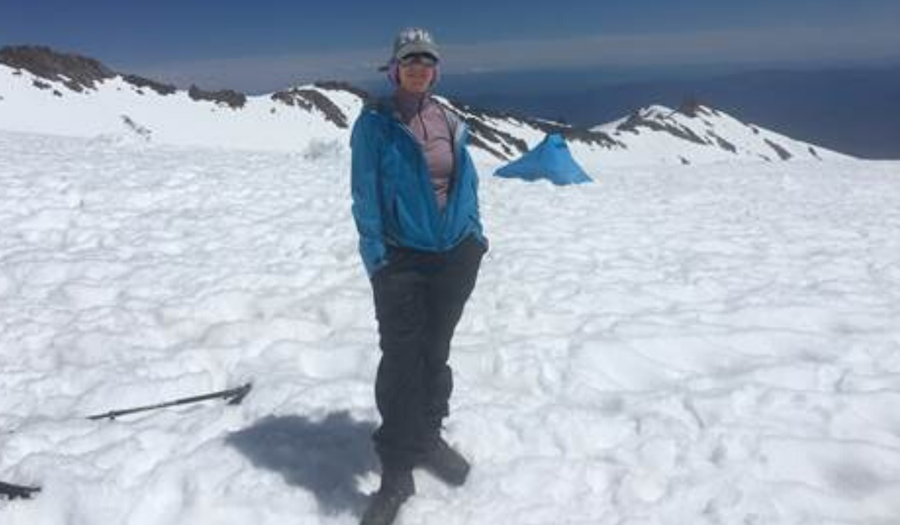8 Life Lessons I Learned From Climbing Mount Shasta

A few years ago, I fulfilled a lifelong dream: climbing Mt. Whitey–which my parents had done in their youth with great pride. During the climb, I learned something about myself: I’m part mountain goat. I’d already known that the Sierras ventilate my soul, but the recognition that I am a pretty relentless wilderness trekker gave me some new goals, like climbing Mt. Shasta. So when my husband’s friend, Ted, said, “let’s do it,” I said, “OK!” We trained on stadium stairs, high altitude hikes, and in spin and yoga classes. For the trip, Ted invited two climbing friends of his and I invited one of my UCLA besties, Erin, of 40+ years.
At the end of June, we packed up our crampons, ice axes, helmets, and 50-pound packs to climb Mount Shasta, the second highest peak in the Cascades and the fifth highest peak in California at 14,179 feet.
Here are some lessons I learned from the experience that apply to life off the mountain as well.
- The longest distance between point A and B is between your two ears
Climbing the mountain is both a mental and physical game. I’d prepared and trained, but that little voice in my head injected doubt: “I cannot do this.” “I am so cold.” “Going this far is enough.” No! Ignore that voice. It is a distraction. You’ve got this!
- When you fall, get up
The hardest part of the climb is coming down. The climb to the summit is steep and rigorous requiring climbing gear and snow travel skills. You start at 10,400 feet, climb to the peak at 14,179 feet, and slog back down to the trailhead at 7,000 feet, all while wearing a 50-pound backpack for much of it. In the afternoon, the snow is shin-deep slush. Exhaustion = an understatement. I fell dozens of times. Sitting there on my wet ass, I have three choices: 1. Call for a helicopter ($100,000). 2. Die and be carried down on a sled. 3. Get up and keep going. Tired and wrecked, I stand up and walk straight ahead, one step in front of the other.
- Don’t drop your ice axe
The guide told us, “Whatever you do, don’t drop your ice axe.” When someone in our group dropped her ice axe, it flew down the mountain with our guide leaping after it in a panic. I listened to every word my expert guide said after that. It can save your life if you slip, start sliding down the mountain, and need to arrest your fall, as I did.
- Be prepared
Don’t try to climb Mt. Shasta without training, getting the right gear, or praying to the weather gods. Otherwise, you’ll sabotage yourself and put your team in danger. It took me months to prepare, and even then, I was at the outside limit of my ability. It’s OK to take a pass if you cannot get prepared. No one in the group is happy or safe unless everyone is prepared.
- Minimize your stuff
The mountain is unforgiving. Bring a positive attitude and buff body but leave extra gear, clothes, and gadgets at home. Traveling light is a relief.
- There’s no reason to be self-conscience
Human beings are made the same. Whether rich, poor, gorgeous, gritty, or glam, people need to defecate, pass gas, wipe away snot, emit odors, burp. That’s life. Carry on.
- Bring an offering
It can get monotonous on the mountain step after step. Bring an offering to the mountain gods and your companions to lift your spirits. Sing a song. (Mine are Brandy and American Pie.) Recite poetry, tell jokes, dissect political chaos.
- Respect the Mountain
The mountain can take you down. I learned to respect the challenge, the weather, the technical requirements, the danger and opportunity, the vulnerability and magnificence. After all, I was crazy enough to take this adventure, so I needed to find my groove, not complain, and kill it!
This essay was featured in the December 1st edition of The Sunday Paper. The Sunday Paper inspires hearts and minds to rise above the noise. To get The Sunday Paper delivered to your inbox each Sunday morning for free, click here to subscribe.

